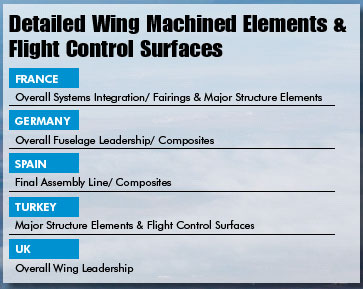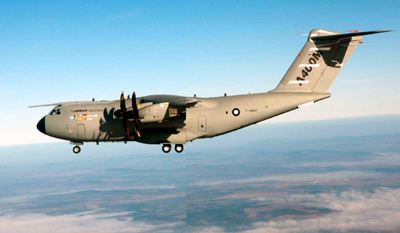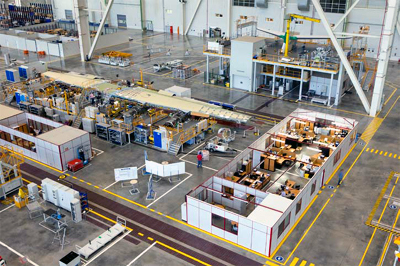|
 The
A400M has the capability to fly distances up to
4,700 nm / 8,700 km, at a cruising altitude of
up to 37,000 ft, and at a speed of up to Mach
0.72, very similar to that of a jet liner. This
gives it the potential for strategic/logistic
missions. Flying faster and higher, it can respond
more rapidly to crises, because greater distances
can be flown in a one crew duty day. The
A400M has the capability to fly distances up to
4,700 nm / 8,700 km, at a cruising altitude of
up to 37,000 ft, and at a speed of up to Mach
0.72, very similar to that of a jet liner. This
gives it the potential for strategic/logistic
missions. Flying faster and higher, it can respond
more rapidly to crises, because greater distances
can be flown in a one crew duty day.
The new aircraft is hence regarded as much more
efficient than its predecessors. Also, as it can
fly higher, it can cruise above turbulence, resulting
in less fatigue for the crew and passengers or
troops alike.
Addressing a group of international journalists
recently during a Trade Media Briefing at Sao
Paulo, Seville, Spain, Rafael Nogueras Cebrero,
Head of A400M Final Assembly Line and Flight Test
Centre, announced that the production of first
customer aircraft MSN 7 had been launched and
will be on the FAL by the end of 2011. Eight countries,
eight operators and 184 aircraft are providing
a strong customer base for a smooth start of the
production line.
A400M can perform missions which previously required
two - or more - different types of aircraft, and
which even then provided an imperfect solution.
Its fuselage’s external width of 5.64 metres
/ 18 ft 6 in is equal to that of the A330/A340
wide-body. The inside usable width of four metres
/ 13ft, height of up to four metres / 13ft, and
usable length of nearly 18m / 59ft, allows it
to carry numerous items of outsize cargo including,
for example, an NH90 or a heavy lift CH-47 Chinook
helicopter, or two Stryker infantry carrier vehicles
(ICV) for military purposes.
 It
can also carry a semi-articulated truck with a
6m / 20ft container, or a rescue boat, or large
lifting devices, such as excavators or mobile
cranes needed to assist in disaster relief, informed
Rafael. It
can also carry a semi-articulated truck with a
6m / 20ft container, or a rescue boat, or large
lifting devices, such as excavators or mobile
cranes needed to assist in disaster relief, informed
Rafael.
Furthermore, the A400M is the only airlifter
that can fly these items directly to the site
of action thanks to its unique landing characteristics.
With its 12- wheel main landing gear designed
for operations from stone, gravel or sand strips,
its efficient absorption of shock-loads into the
airframe structure, and its minimised risk of
foreign object damage, the A400M is able to land
on, and take-off from, short, soft and rough unprepared
airstrips meeting the CBR6 standard.
Once on the ground, the A400M is designed for
very rapid and autonomous cargo unloading or loading
without any specialized ground support equipment.
Equipped with on-board winches and a crane, the
cargo hold is optimised for single loadmaster
operation from a computerised workstation, where
the loadmaster can pre-plan loading from a loads
data base. So, by minimising the time on the ground,
the A400M’s systems also reduce the aircraft’s
vulnerability to hostile action.
Being able to fly at higher altitudes and faster,
it can also be configured into a tanker aircraft
to refuel military fast jets (fighters) and other
large aircraft at speeds of up to 300kt indicated
air speed (IAS) at 25,000ft. But because of its
low speed performance, it can equally well refuel
helicopters at 110kt up to 5,000ft.
Refuelling can be done either through two wing-pod
hoses or through a centre-line fuselage refuelling
unit. Its built-in air-toair refuelling capability
allows it to be rapidly re-configured to become
a tanker. It can therefore be easily adapted to
rapidly changing operational scenarios, being
able to perform very different types of missions,
as needed. The aircraft itself can also be refuelled
in flight.
A400M has been specifically designed for low
detectability, low vulnerability and high survivability,
giving it excellent self-protection. With clean
and minimised infra-red signature engines, highly
responsive fly-by-wire flight controls, four independent
control computers, comprehensive defensive aids,
cockpit armouring and damage tolerant controls,
the A400M is hard to find, hard to hit and hard
to kill. As for its “down-time”, the A400M is
conceived to be what the ccompany says “the most
reliable airlifter ever.”
It needs only 84 days of scheduled downtime maintenance
in 12 years, Rafael informed India Strategic.
The nations in the project, which is otherwise
delayed, include Belgium, France, Germany, Italy,
Luxemburg, Portugal, Spain, Turkey, and the United
Kingdom.
Meanwhile, the aviation manufacturers of these
countries have also started working on the concept
of a new military transport under the designation
of “Future Large Aircraft” (FLA).
 They
involve Aerospatiale in France, Deutsche Aerospace
(DASA) in Germany, British Aerospace in the UK,
CASA in Spain, the industries of Belgium and Luxemburg
which joined forces under the FLABEL grouping,
as well as Alenia in Italy, OGMA in Portugal,
and the Turkish Aerospace Industry (TAI) in Turkey. They
involve Aerospatiale in France, Deutsche Aerospace
(DASA) in Germany, British Aerospace in the UK,
CASA in Spain, the industries of Belgium and Luxemburg
which joined forces under the FLABEL grouping,
as well as Alenia in Italy, OGMA in Portugal,
and the Turkish Aerospace Industry (TAI) in Turkey.
An initial call for tender was launched by the
European Nations in 1998, to which the FLA grouping
responded in 1999. After thorough examination
of the various options which included other existing
products and even co-operation with nonwest- European
manufacturers, the FLA proposal was selected by
these countries in July 2000. The initial commitment
was for 288 aircraft from all the eight countries.
On 21st December 2001, an initial contract was
signed for a total of 197 A400Ms, as the aircraft
was to be called from then on, by the European
nations, but without Italy which had withdrawn
from the launch-nations group. The German order
for 73 aircraft was subject to hand-written budget
approval, which was eventually obtained at the
beginning of 2003, but for only 60 aircraft.
Meanwhile, Portugal had also withdrawn from the
initial group. The final contract for 180 aircraft
was signed with OCCAR, representing Belgium, France,
Germany, Luxemburg, Spain, Turkey, and the UK
on 27th May 2003. This was to be followed by an
order for four by Malaysia in December 2005.
Orders which stand to date are total 184 from
8 countries (Germany 60, France 50, Spain 27 ,UK
25,Turkey 10, Belgium 7 and Luxemburg 1. Malaysia
has ordered four of these and is the only Asian
client yet).
The A400M can also very easily be converted into
an aerial refuelling tanker. Because all provisions
are built into the airframe, it takes under two
hours to convert the A400M from an airlifter into
a two-point tanker aircraft. Hard points, fuel
lines and electric connections are already built
into the wings. The two refuelling pods under
the wing can provide a fuel flow of up to 1,200
kg / 2,645lb per minute. The centre-line fuselage
refuelling unit provides a fuel flow of some 1,800
kg /3,968 lb per minute. Three video cameras can
be installed if desired, to monitor the refuelling
from the wing pods and the centreline unit.
The A400M carries up to 64,000 litres /14,078gallons
of fuel in its wings and centre wing box. Two
additional cargo hold units can also be installed,
providing an additional 7,200 litres /1,583 gallons
of fuel each.
The fuel carried in the extra tanks can be of
a different nature to the fuel in the main tanks.
This enables the A400M to cater for the needs
of different types of receiver aircraft. Also,
because of its low fuel consumption, the A400M
can do a 4-hour mission while off-loading some
35 tonnes /78,400 lb of fuel. Larger aircraft
can also be refuelled by the A400M.
 Rafael
said that the A400M is the only tanker which can
refuel the entire range of military aircraft at
their preferred speeds and altitudes. This is
because it can fly both at the low speeds and
altitudes (105 to 115 kt) typically required to
refuel helicopters, as well as at speeds of 280
to 300 kt and altitudes of around 25,000 ft which
are typical for fast jets, such as fighters or
large aircraft. Rafael
said that the A400M is the only tanker which can
refuel the entire range of military aircraft at
their preferred speeds and altitudes. This is
because it can fly both at the low speeds and
altitudes (105 to 115 kt) typically required to
refuel helicopters, as well as at speeds of 280
to 300 kt and altitudes of around 25,000 ft which
are typical for fast jets, such as fighters or
large aircraft.
The A400M can accommodate up to 116 troops sitting
face to face, alongside the fuselage and backto-
back along the centre line of the aircraft. Its
wider fuselage which provides more space between
the rows, it can carry the same number of fully
equipped paratroopers with their chutes and related
equipment. They can be dropped in less time over
a limited area, allowing them to swiftly regroup
and to be quickly operational.
But above all , the A400M permits two paratroopers
to jump simultaneously either through the cargo
door or through the two lateral doors. Special
forces can also be dropped from altitudes as high
as 40,000 ft.
Another key feature of the A400M is its computerized
“fly-by-wire” flight controls already widely used
on other civil transport aircraft, starting with
the A320. Replacing the conventional cables and
pulleys by electrical wires linked to four independent
flight control computers which send signals to
actuators, not only reduces weight, but also maintenance
time. This also gives a much greater precision
to the commands. The fly-by-wire controls permit
the implementation of “flight envelope protection”
which, by preventing the aircraft from stalling,
allows the pilot to achieve optimum performance
in a critical escape manoeuvre by simply pulling
the full stick back. The fly-by-wire system then
manages the whole aircraft configuration accordingly,
without the pilot having to intervene.
One of the key elements to ensure the versatility
of the A400M was the selection for the aircraft
of an allnew, specifically designed three-shaft
turboprop engine with eight bladed propellers.
The 11,000 shp TP400 developed by EuroProp International
(EPI), a consortium comprising Rolls Royce, Snecma,
MTU and ITP, is the most powerful turboprop ever
built.
Ed Strongman, the Chief Test Pilot Airbus Military
told India Strategic that till 19thMay 2010, the
A 400M had undergone 43 test flights and 165 hours
of flying. He also said that an initial problem
of the brakes had been rectified to achieve perfect
landing.
The aircraft’s flight campaign is progressing
well at two Flight Test Centres at Touluse in
France and at Seville, said Strongman.
|